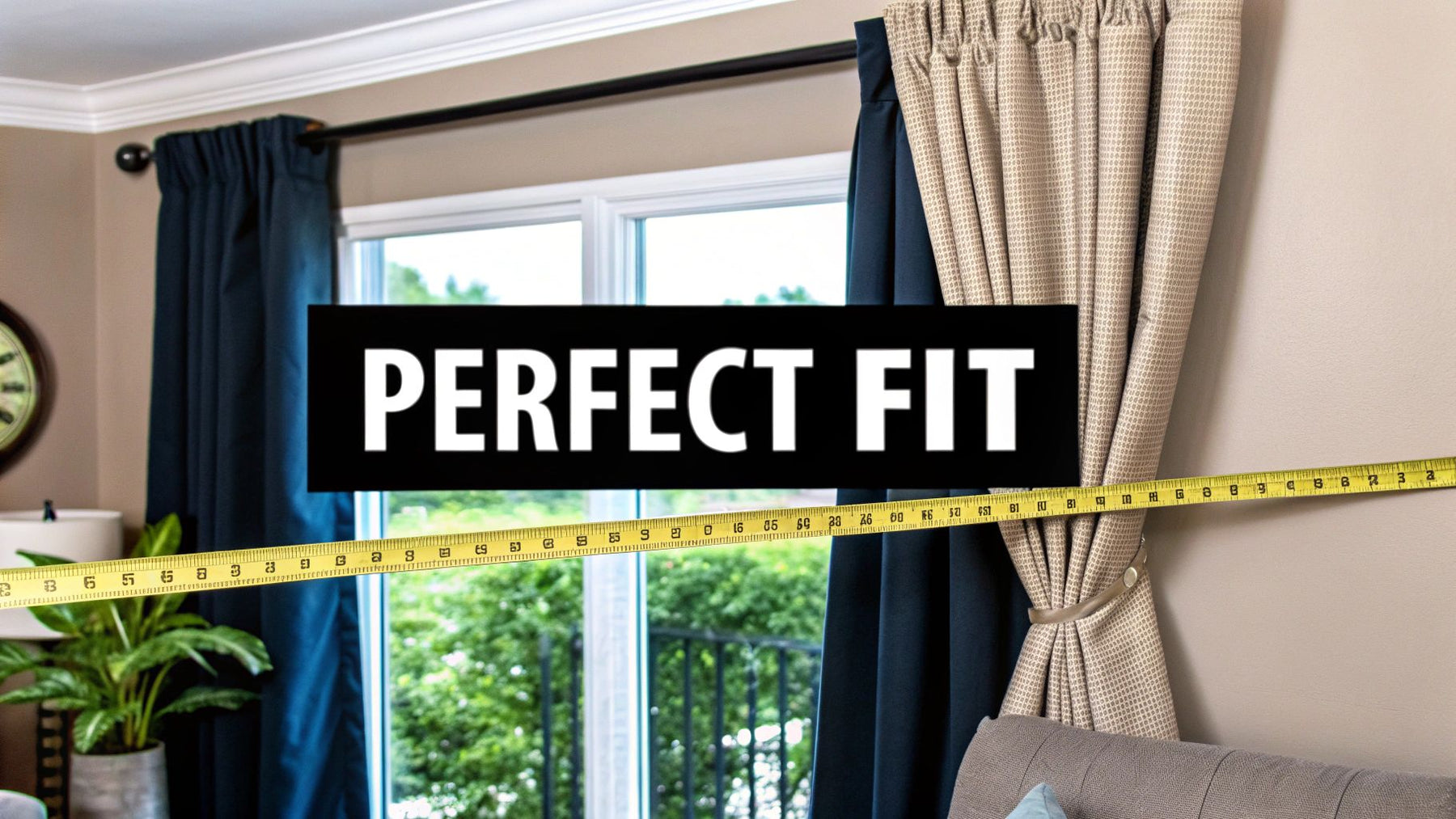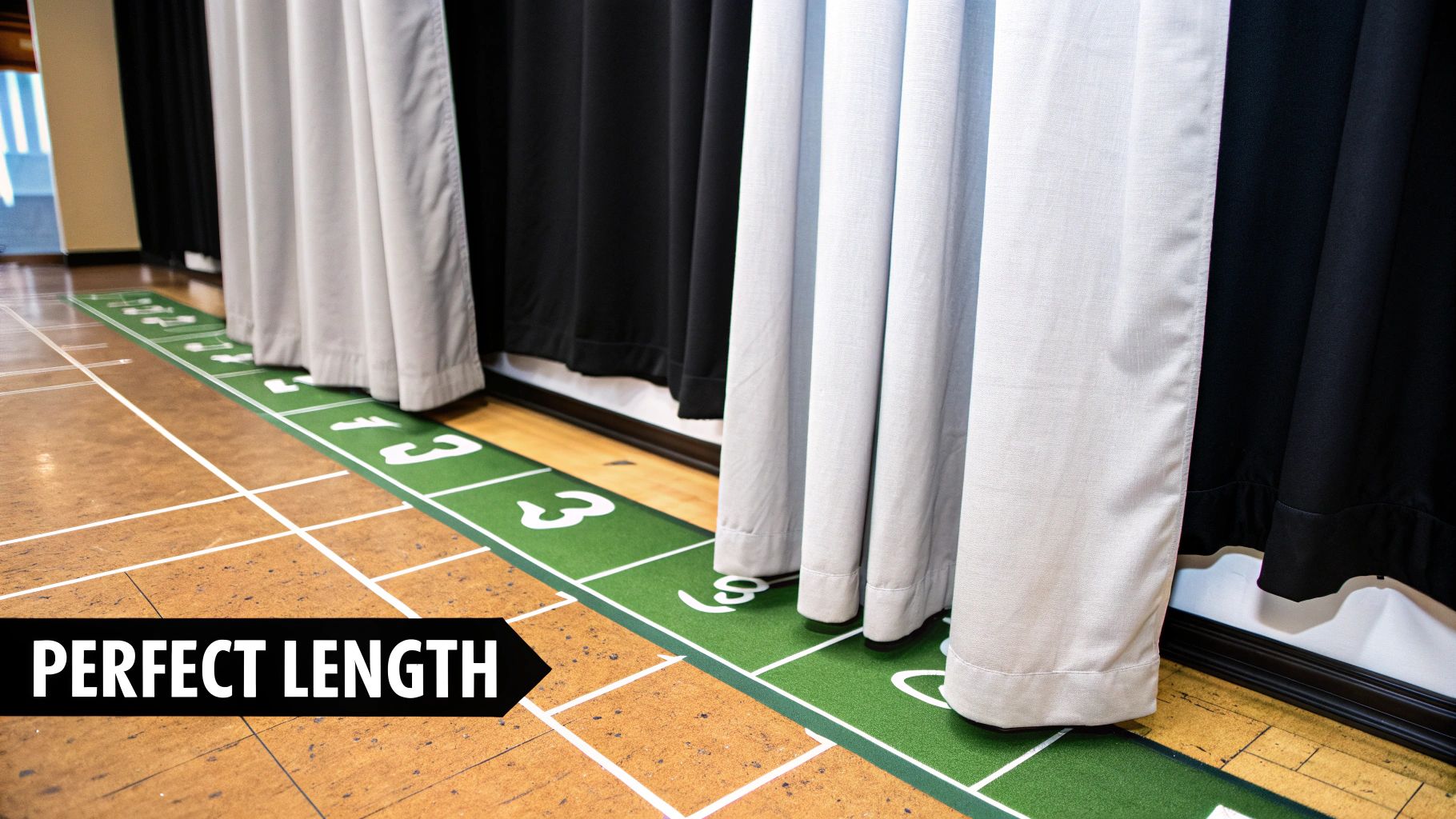
The Ultimate Curtains Measuring Guide for a Perfect Fit
Getting your measurements right is the secret to beautiful window treatments. This comprehensive curtains measuring guide isn't just about covering glass—it's about intentional design that elevates your entire space. With just a few precise numbers, you can make a room feel taller, wider, and instantly more polished.
Ready to measure like a pro? Let's get started.
Table of Contents
- Why Precise Curtain Measurements Transform Your Room
- Gathering Your Essential Measuring Tools
- Getting Curtain Width and Fullness Right
- Choosing and Measuring the Perfect Curtain Length
- Common Measuring Mistakes and How to Avoid Them
- Frequently Asked Questions
Why Precise Curtain Measurements Transform Your Room

Think of curtains as the frame for your room's best feature: your windows. Even small measurement mistakes can throw off the whole vibe, making a space feel awkward or unfinished. Getting it right is the single most critical step toward achieving that professional, high-end look without hiring a designer.
The real difference comes down to understanding two key principles: fullness and length.
- Fullness Defines Luxury: The width of your curtains gives them that luxurious, gathered appearance when closed. If you only measure the window frame, you'll end up with flat, lifeless panels. The right technique adds wonderful visual depth and softness.
- Length Sets the Mood: The curtain's drop—where it ends relative to the floor—completely dictates the room's atmosphere. A slight float feels clean and modern, while a dramatic puddle gives off a romantic, traditional feel.
This growing attention to detail is why the global market for window treatments is booming. Projections show the curtains and window blinds market could soar past USD 44.58 billion by 2035, driven by a rising demand for thoughtful home decor. Homeowners are realizing that small details like curtain measurements are a huge part of creating a stylish, cohesive home.
Expert Take: Getting the hang height and width correct is like tailoring a suit—it instantly makes everything look more expensive and put-together. You're not just buying fabric; you're investing in your home's atmosphere.
Understanding these foundational principles ensures that when you finally pick from a diverse range of curtains, you're choosing something that perfectly complements your space. This guide will give you the confidence to measure any window like an expert.
Gathering Your Essential Measuring Tools
Before you begin, taking a few minutes to get organized will make the entire process smoother. Think of it as your pre-flight checklist. Having the right gear on hand from the start saves you from frustrating interruptions and ensures your numbers are spot-on.
You don’t need a fancy professional kit, just a few key items. A little preparation now is what stands between you and a costly mistake later.
Your Measurement Toolkit
To get started, make sure you have these items ready:
- A Metal Tape Measure: This is your most important tool. Unlike a soft tailor's tape, a rigid metal one won’t sag or stretch, which means you get a precise, trustworthy reading every time.
- A Notepad and Pencil: Whether it's a classic pad or the notes app on your phone, you absolutely need a place to write down your numbers. Don't trust it to memory!
- A Sturdy Step Stool: Safety first. For taller windows, a secure step stool is non-negotiable for reaching the top of the frame safely and getting an accurate measurement.
Pro Tip: If you're tackling a wide window, grab a friend to help. An extra pair of hands is a lifesaver for keeping the tape measure level and tight. Once you have your numbers, our guide on how to hang curtains properly will walk you through what comes next.
Getting Curtain Width and Fullness Right
One of the biggest mistakes people make is measuring only the window frame. To get that polished, professional look, you must measure the full length of your curtain rod or track—excluding the decorative finials at the ends. This one shift makes all the difference.
Why is this so important? A well-placed rod should extend 3 to 6 inches past the window frame on each side. This trick stops annoying light from peeking in and creates an illusion, making your window feel much larger and grander.
The Secret to a Luxurious Look: Fullness
Getting the width right is only half the battle. True curtain artistry is about achieving the perfect fullness—the design term for how much gathered fabric creates those beautiful, soft waves. Curtains stretched flat look accidental, but lush, full curtains are a clear sign of high-end, intentional design.
Figuring this out is simple. You’ll multiply your curtain rod's total length by a "fullness multiplier," which changes based on the header style (like pencil pleat vs. grommet). This formula is key to getting that coveted, voluminous look.
The infographic below shows how the 'Fullness Factor' transforms your window treatments from basic to beautiful.

As you can see, extending the rod and adding the right amount of fullness is what creates a dramatic, completely finished result.
How To Calculate Your Ideal Curtain Width
To nail the perfect amount of fabric, the goal is simple: the total width of your curtain panels needs to be much wider than your rod.
Here’s a quick guide to follow:
- For a standard, full look: Aim for a combined curtain width that is 1.5 to 2 times the length of your curtain rod.
- For a more dramatic, opulent feel: Go for a multiplier of up to 2.5 or even 3 times the rod length. This works especially well with sheer or lightweight fabrics.
Example: Let’s say your curtain rod measures 80 inches. For a classic full look, you'd want your total curtain panel width to be somewhere between 120 inches (80 x 1.5) and 160 inches (80 x 2). This ensures that even when the curtains are closed, they still have that graceful, gathered appearance.
Curtain Fullness Multiplier Guide
To achieve that professional, gathered look, the curtain header style plays a big role. Different headers create different pleats and folds, so they require different fullness multipliers.
Here's a handy table to guide you:
| Curtain Header Style | Recommended Fullness Multiplier | Visual Effect |
|---|---|---|
| Pencil Pleat | 2 to 2.5 | Creates tight, small pleats for a traditional, full look. |
| Grommet (Eyelet) | 1.5 to 2 | Forms deep, uniform waves that look modern and sleek. |
| Rod Pocket | 2 to 2.5 | Gathers the fabric tightly for a casual, shirred effect. |
| Tab Top | 1.5 to 2 | Creates soft, informal folds between the fabric tabs. |
| Pinch Pleat | 2 to 2.5 | Offers a tailored, decorative look with structured pleats. |
To make the math even easier, you can use our handy curtain width calculator to get a precise number in seconds. When you get this detail right, your new window treatments will look like they were made just for you.
Choosing and Measuring the Perfect Curtain Length

While width adds fullness, it’s the length—what designers call the ‘drop’—that truly sets the room's tone. If the length is off, the whole look can feel awkward. That's why this part of our curtains measuring guide is all about getting that stylistic detail just right.
Your measurement should always start from where the curtain will hang. That could be the top of the curtain rod or, if you're using them, the bottom of the curtain rings. From there, measure straight down to where you envision the fabric ending.
Three Designer-Approved Lengths
Interior designers usually lean on three classic curtain lengths, each bringing a different feel to a room.
- The Float: The hem hangs about a half-inch above the floor. It's a no-fuss style perfect for high-traffic areas, kids' rooms, or homes with pets because the fabric stays clean.
- The Kiss: For a crisp, tailored finish, this length has the curtain just barely skimming the floor. It looks incredibly intentional, but it demands super accurate measurements.
- The Puddle: This is your most dramatic and romantic option. Add an extra 1 to 3 inches of fabric to your measurement so it pools elegantly on the floor. It’s best reserved for luxurious fabrics in low-traffic spots like a formal dining room.
The length you choose directly impacts the room's formality. A clean "float" feels casual and modern, while a "puddle" introduces a touch of old-world drama. There's no wrong answer—just the one that feels right for your space.
Matching Length to Your Lifestyle
Think about how you actually live in the room. That gorgeous puddle look might be a tripping hazard in a living room where kids and pets play, but it could be stunning in a quiet, formal space.
This kind of personalized home decor is a huge part of why the window coverings industry is booming. The global market for curtains and blinds is on track to hit USD 57.6 billion by 2034, as homeowners invest in custom details.
Picking the right drop is a make-or-break part of your project. For more examples, see our complete guide to curtain lengths to visualize what will look best in your home.
Common Measuring Mistakes and How to Avoid Them
Even with the best intentions, a few common slip-ups can derail your curtain project. Getting these details right from the start is the secret to a flawless, professional finish.
One of the most frequent blunders is measuring the window frame itself. Your rod should always extend beyond the frame—this classic designer trick makes the window appear larger while blocking out more light. If you only measure the glass, you’ll end up with skimpy panels that won't give you the coverage you need.
Another easy mistake? Forgetting to account for the hardware.
Overlooking the Small Details
It’s often the little things that make the biggest difference. Here are a few specifics that are easy to miss but crucial to get right:
- Forgetting Rings or Clips: If you’re using curtain rings, your length measurement must start from the bottom of the ring, not the rod. Ignoring this can leave your curtains an inch or two shorter than you wanted.
- Ignoring Fabric ‘Shrinkage’: Natural fibers like linen can shrink slightly after their first wash. If you plan on cleaning your curtains at home, it’s smart to add an extra inch to the length, just in case.
- Not Double-Checking: This sounds simple, but it’s the most important. Measure everything twice—or even three times—before you order. A quick re-check takes seconds but can save you a massive headache.
The old carpenter’s rule, "measure twice, cut once," is the absolute golden rule of window treatments. Taking an extra minute to confirm your numbers is the best thing you can do to guarantee a perfect fit.
Globally, more people are focusing on getting these home details right. This trend is especially noticeable in regions like Asia-Pacific, where an expanding middle class is driving serious growth in the home decor market. If you're interested in the trends, you can explore the latest research on the global curtains market.
Frequently Asked Questions
Even with the best guide, a few questions often pop up. Here are our answers to the most common queries we hear about measuring for curtains.
How far above the window should I mount my curtain rod?
The short answer is 4 to 6 inches above the top of the window frame. This classic interior designer trick draws the eye upward, creating the illusion of height and making the entire room feel more grand. For rooms with standard 8-foot ceilings, you can even go higher and place the rod about halfway between the window frame and the ceiling for extra drama.
Should my curtains touch the floor?
This decision depends entirely on your personal style and the room's function. There are three excellent options:
- Float (Practical): Curtains hang about a half-inch above the floor. This is ideal for high-traffic areas, kitchens, or kids' rooms as the fabric stays clean.
- Kiss (Tailored): The hem just grazes the floor. It offers a very clean, custom-made look but requires precise measurements.
- Puddle (Dramatic): Add an extra 1 to 3 inches of length so the fabric pools on the floor. This looks luxurious but is best for low-traffic spaces.
What is "stackback" and why do I need to consider it?
Stackback is the space your curtains take up on the side of the window when they are fully open. It's an essential detail for maximizing natural light. If you don't account for stackback, your open curtains will cover part of the glass, making the window look smaller and the room feel darker. To avoid this, your curtain rod should be wide enough for the panels to "stack" on the wall, completely clear of the window. As a general rule, add about 15-25% of your window’s total width to your curtain rod measurement.
Ready to put your new measuring skills to the test? Explore the beautiful and diverse collection of window treatments at Joey'z Shopping and find the perfect curtains to complete your space. Visit us today at https://joeyzshopping.com to start shopping.
